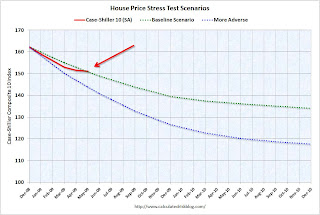by Calculated Risk on 7/28/2009 10:48:00 AM
Tuesday, July 28, 2009
Case-Shiller House Price Seasonal Adjustment and Comparison to Stress Tests
Case-Shiller released the May house price index this morning, and most news reports focused on the small increase, not seasonally adjusted (NSA), from April to May. As I noted earlier, the seasonally adjusted (SA) data showed a small price decline from April to May.
Case-Shiller reported that prices fell at a 2.5% annual rate in May (SA).
However I think the seasonal factor might be insufficient during the current period.
The following graph shows the month-to-month change of the Case-Shiller index for both the NSA and SA data (annualized). Note that Case-Shiller uses a three-month moving average to smooth the data. Click on graph for larger image in new window.
Click on graph for larger image in new window.
The Blue line is the NSA data. There is a clear seasonal pattern for house prices.
The red dashed line is the SA data as provided by Case-Shiller.
The seasonal adjustment appears pretty good in the '90s, but it appears insufficient now. I expect that the index will show steeper declines, especially starting in October and November.
The second graph compares the Case-Shiller Composite 10 SA index with the Stress Test scenarios from the Treasury (stress test data is estimated from quarterly forecasts).
NOTE: I'm now using the Seasonally Adjusted (SA) composite 10 series. The Stress Test scenarios use the Composite 10 index and start in December. Here are the numbers:
The Stress Test scenarios use the Composite 10 index and start in December. Here are the numbers:
Edit correction: All data for May.
Case-Shiller Composite 10 Index, May: 151.13
Stress Test Baseline Scenario, May: 150.85
Stress Test More Adverse Scenario, May: 143.81
So far house prices are tracking the baseline scenario, but I believe the seasonal adjustment is insufficient and prices will decline faster in the Fall.


